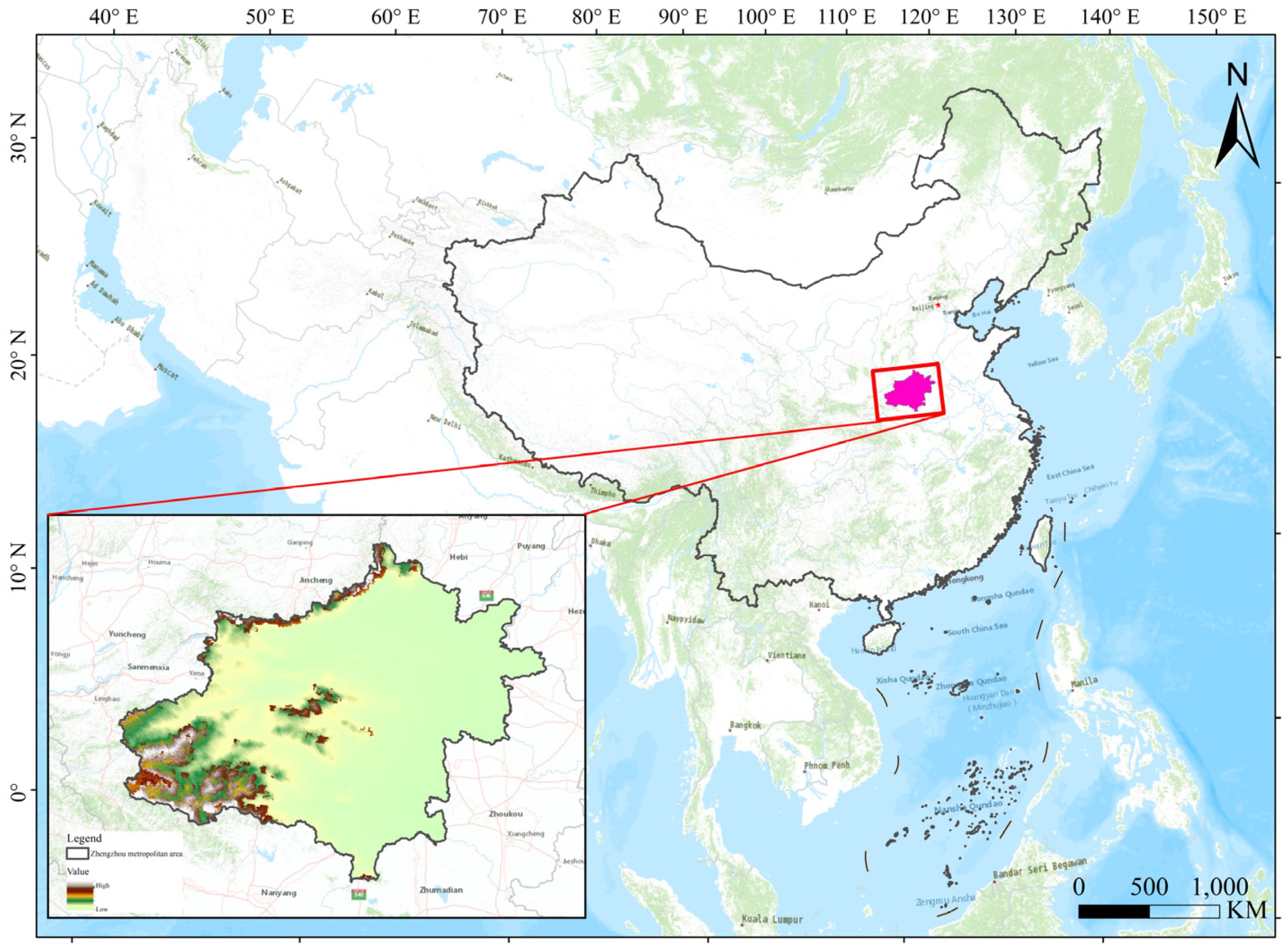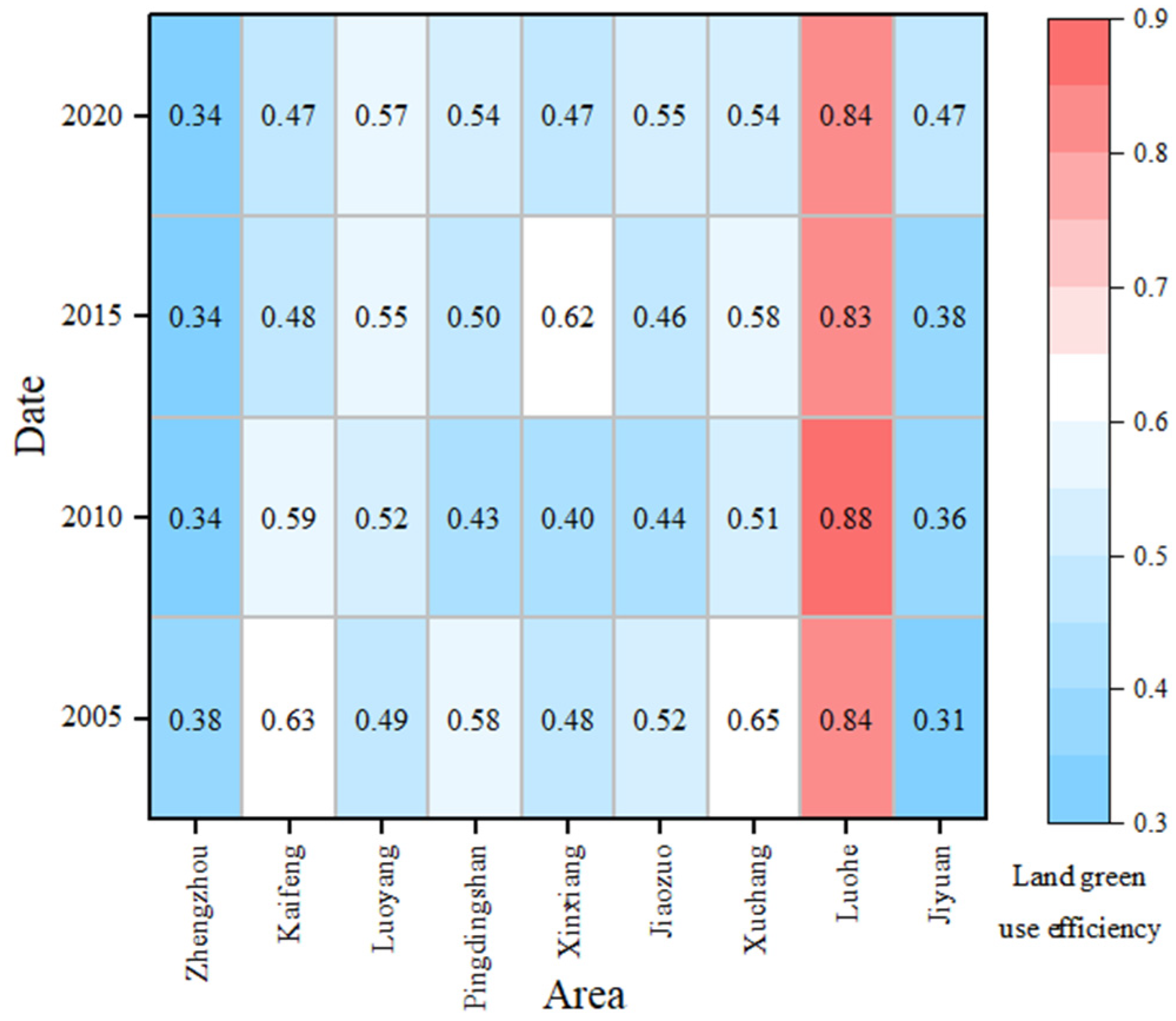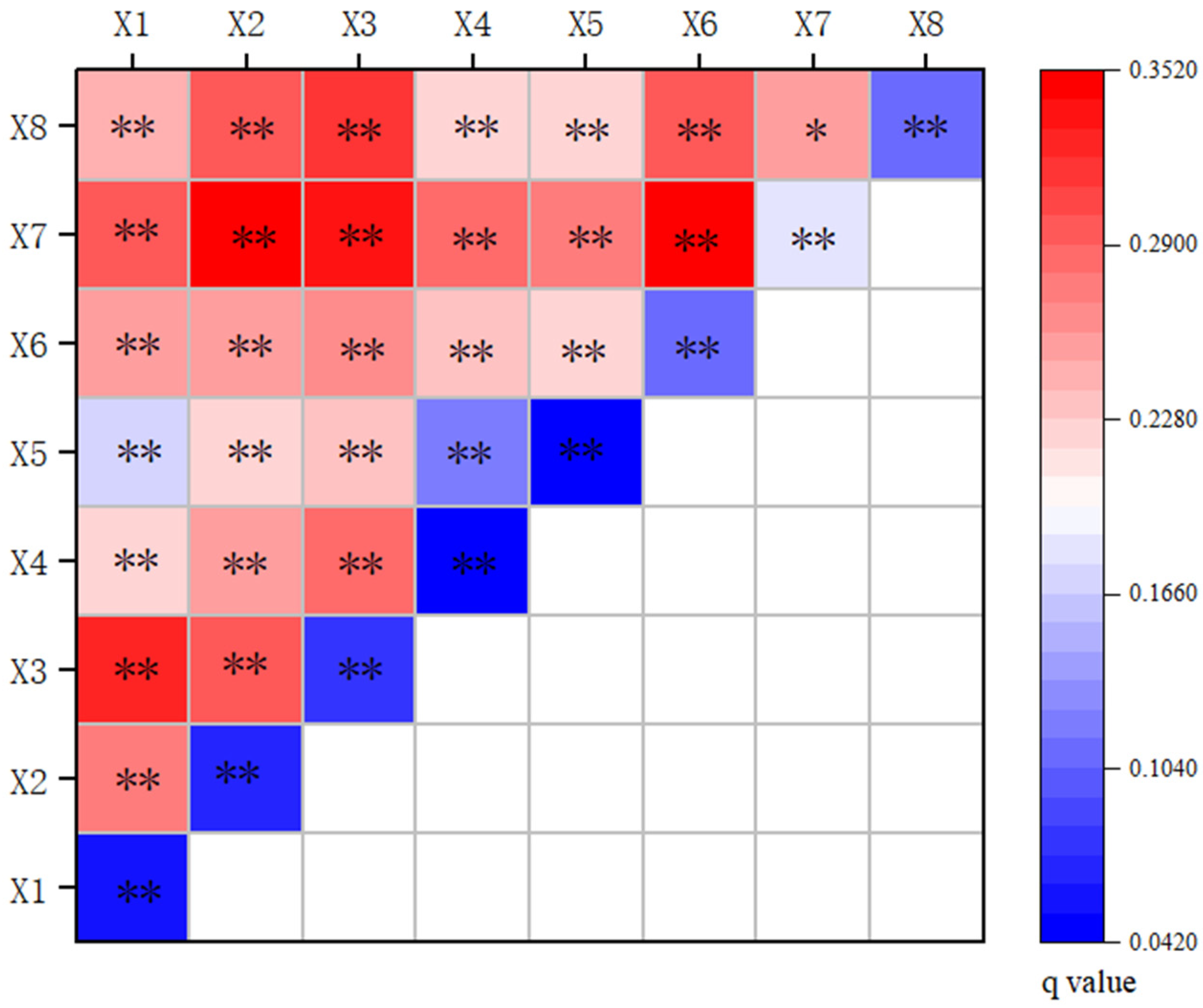Land Green Utilization Efficiency and Its Driving Mechanisms in the Zhengzhou Metropolitan Area
Abstract
1. Introduction
2. Materials and Methods
2.1. Overview of the Study Area
2.2. Evaluation Index System
2.2.1. Evaluation Index System of Land Green Use Efficiency in Zhengzhou Metropolitan Area
2.2.2. Driving Factor Index System of Land Green Use Efficiency in Zhengzhou Metropolitan Area
2.3. Research Methods
2.3.1. Super Efficient SBM Model with Unexpected Output
2.3.2. Spatial Autocorrelation Method
- (1)
- Global spatial autocorrelation analysis is used to describe the overall distribution of a phenomenon and determine whether the phenomenon has agglomeration characteristics in space. In this paper, the Moran index is used to measure the global spatial autocorrelation. The value range of Moran’s I coefficient is [−1, 1]. When the value of Moran’s I is greater than 0, it indicates that the land green use efficiency in the Zhengzhou metropolitan area has a spatial positive correlation and shows an aggregation distribution. When the value of Moran’s I is less than 0, it indicates that the land green use efficiency of the Zhengzhou metropolitan area has a spatial negative correlation and presents a spatial differentiation. When the value of Moran’s I is close to 0, it presents a random distribution without autocorrelation. The formula is [27].
- (2)
- Local spatial autocorrelation analysis. Since global Moran’s I is a comprehensive measure of spatial autocorrelation of land green use efficiency in the Zhengzhou metropolitan area, reflecting the average degree of spatial correlation, and there may be some positive and negative spatial correlation coexistence of land green use efficiency in the Zhengzhou metropolitan area, it is necessary to adopt local spatial autocorrelation statistics to reveal the possible spatial variability. The formula is [23]
2.3.3. Geographical Detector Model
2.4. Data Sources
3. Result Analysis
3.1. Spatial-Temporal Pattern of Land Green Use Efficiency in Zhengzhou Metropolitan Area
3.2. Spatial-Temporal Heterogeneity of Green Land Use Efficiency in the Zhengzhou Metropolitan Area
3.3. Analysis of Driving Mechanism of Land Green Use Efficiency in Zhengzhou Metropolitan Area
4. Discussion
- (1)
- From the perspective of time series changes, the land green use efficiency of the Zhengzhou metropolitan area fluctuated from 2005 to 2020. By 2010, the average efficiency of the Zhengzhou metropolitan area was 0.48, a decrease of 0.05 compared with 2005, and by 2015, the average value of land green use efficiency increased to 0.52. By 2020, the average efficiency showed an insignificant decrease of 0.002. From 2005 to 2020, the green land use efficiency of Luohe City was the highest, and that of Zhengzhou City was the lowest, and the change of both was relatively stable. The change of Xinxiang City was the most drastic, Luoyang City and Jiyuan City continuously increased, while Kaifeng city and Xuchang City decreased significantly. The land green use efficiency of all counties in Luohe City was generally high, while the land green use efficiency of all counties in Zhengzhou City was generally low. It was higher in the west and southeast of the Zhengzhou metropolitan area, and lower in the central and northern areas. The efficiency values of different intervals show the characteristics of overall continuous distribution and local scattered distribution in space.
- (2)
- From the perspective of spatial differentiation patterns, the global Moran’s I index of land green use efficiency in the Zhengzhou metropolitan area increased from 0.1472 in 2005 to 0.4114 in 2015, and decreased to 0.2991 in 2020. The global spatial autocorrelation first increased and then decreased. The global spatial autocorrelation showed a strengthening trend during the whole study period. The local spatial autocorrelation had high-high clustering, high-low clustering, low-high clustering, and low-low clustering, which were concentrated in the west, southeast and central regions of the Zhengzhou metropolitan area, and there is a large space for collaborative improvement and optimization in each region.
- (3)
- From the perspective of driving factors, the eight influencing factors of land green use efficiency in the Zhengzhou metropolitan area all passed the 5% significance level test, and the explanatory power is shown as topographic relief > forest coverage rate > social consumption > industrial structure > urbanization rate > economic development > industrial added value scale > financial expenditure, among which topographic relief is the leading influencing factor. The explanatory power is 0.1856. In the two-factor interaction, topographic relief and forest coverage rate showed nonlinear enhancement, and the rest showed a two-factor enhancement relationship. Topographic relief had strong interaction with urbanization rate, industrial structure upgrading and social consumption, and the highest explanatory power was 0.3513, 0.3370, and 0.3494, respectively. The results showed that the greater the relief degree, the worse the green use of urban land, and the increase of forest coverage rate had a significant positive effect on the green use of urban land.
- (4)
- Compared with the existing research on land green use efficiency, this paper profoundly reveals the spatial correlation of land green use efficiency in the Zhengzhou metropolitan area and profoundly reflects its dynamic change process. It is more clearly proved that by using the more accurate data of 120 counties in the Zhengzhou metropolitan area as the research object, compared with existing results mainly based on a wider research area, more specific influencing factors and countermeasures can be obtained. Moreover, the research results show that in contrast to the dominant economic driving factors in the past [15], in the 120 counties of the Zhengzhou metropolitan area, the two environmental factors of topographic relief and forest coverage rate have a more significant effect on the land green use efficiency, indicating that economic growth leads to rapid urbanization. However, it is not necessarily conducive to the improvement of urban land use efficiency [3], which can provide more accurate and detailed scientific data support for low-carbon green development and efficient utilization of resources in the Zhengzhou metropolitan area.
5. Policy Impact and Further Research
Author Contributions
Funding
Data Availability Statement
Conflicts of Interest
References
- Lu, D.; Sun, D. Comprehensive management and sustainable development of the Yellow River Basin. Acta Geogr. Sin. 2019, 74, 2431–2436. [Google Scholar]
- Liu, S.; Ye, Y.; Xiao, W. Spatial and temporal differentiation of urban land use efficiency in China based on stochastic Frontier analysis. China Land Sci. 2020, 34, 61–69. [Google Scholar]
- Song, Y.; Yeung, G.; Zhu, D.; Xu, Y.; Zhao, J. Spatial and temporal pattern of land use efficiency and its driving factors in the Beijing-Tianjin-Hebei urban agglomeration. China Land Sci. 2021, 35, 69–78. [Google Scholar]
- Luo, G.; Li, T. Dynamic change and influencing factors of provincial land use efficiency differences in China under the influence of carbon emissions. Acta Ecol. Sin. 2019, 39, 4751–4760. [Google Scholar]
- Gai, M.; Qin, B.; Zheng, X. Spatial and temporal pattern evolution analysis of coupled coordination between transformation of economic growth momentum and green development. Geogr. Res. 2021, 40, 2572–2590. [Google Scholar]
- Liang, L.; Yong, Y.; Yuan, C. Measurement and spatial differentiation of urban land green use efficiency: Based on an empirical study of 284 cities at or above prefecture level. China Land Sci. 2019, 33, 80–87. [Google Scholar]
- Ding, Y.; Guo, Q.; Qin, M. Spatial and temporal evolution and influencing factors of land green use efficiency in resource-based cities in the Yellow River Basin. Trans. Chin. Soc. Agric. Eng. 2021, 37, 250–259. [Google Scholar]
- Feng, W.; Zhao, R.; Xie, Z.; Ding, M.; Xiao, L.; Sun, J.; Yang, Q.; Liu, T.; You, Z. Land use carbon emission efficiency and its spatial-temporal pattern under carbon neutral target: A case study of 72 prefecture-level cities in the Yellow River Basin. China Land Sci. 2023, 37, 102–113. [Google Scholar]
- Hu, B.; Li, J.; Kuang, B. Evolution characteristics and influencing factors of urban land use efficiency difference under the concept of green development. Econ. Geogr. 2018, 38, 183–189. [Google Scholar]
- Lu, X.; Ren, W.; Yang, H.; Ke, S. Impact of compact urban traffic development on land green use efficiency: An empirical analysis based on spatial metrology. China Popul. Resour. Environ. 2023, 33, 113–124. [Google Scholar]
- Jiang, X.; Hou, J.; Lu, X. The impact of low-carbon pilot policies on urban land green use: An empirical study based on differentially differential model. China Land Sci. 2023, 37, 80–89. [Google Scholar]
- Hu, F.; Zhao, R.; Jia, Z.; Wei, J.; Li, L. Spatial and temporal characteristics of urban land expansion and its influencing factors: Based on panel data from 31 provinces in China. Resour. Dev. Mark. 2022, 38, 939–947. [Google Scholar]
- Xu, Z.; Xu, W.; Liu, C. Impact of environmental regulation on land green use efficiency. China Land Sci. 2021, 35, 87–95. [Google Scholar]
- Zhang, J.; Liang, J.; Zhu, Y.; Zhou, X. Land resources and the influence of the GDP of China’s population distribution mechanism analysis. J. Geogr. Sci. 2017, 37, 1006–1013. [Google Scholar]
- Lu, X.; Li, J.; Liu, C.; Kuang, B.; Cai, D.; Hou, J. Driving factors and spatial differentiation of urban land green use efficiency in China. Sci. Geogr. Sin. 2022, 42, 611–621. [Google Scholar]
- Wen, R.; Li, H.; Wu, R.; Yan, L. Spatial and temporal variation of county land green use efficiency and its influencing factors based on multi-source data in Jiangxi Province. Areal Res. Dev. 2023, 42, 136–142. [Google Scholar]
- Nie, L.; Wang, Y.; Shao, Z.; Wu, Y.; Liu, X. Measurement of urban land use efficiency and its influencing factors: Based on empirical analysis of ten major urban agglomerations in China. Explor. Econ. Probl. 2022, 82–93. [Google Scholar]
- Zhang, Z.; Zhong, J.; Zhao, Z.; Fang, H. Research on urban land use efficiency and its influencing factors in Beijing-Tianjin-Hebei region. China Soft Sci. 2022, 121–126. [Google Scholar]
- Xie, W.; Wu, J. Effects of land use and landscape pattern on PM2.5 concentration: A case study of Shenzhen City. J. Peking Univ. Nat. Sci. Ed. 2017, 53, 160–170. [Google Scholar] [CrossRef]
- Xue, J.; Zhang, A.; Cao, L. Spatial effects of land marketization and supply structure on green use efficiency of construction land in the Yellow River Basin. Resour. Dev. Mark. 2022, 38, 1304–1313. [Google Scholar]
- Zhang, S.; Du, S.; Liu, X.; Niu, W. Spatial and temporal differences and influencing factors of land use eco-efficiency in urban agglomerations of the lower Yellow River. Resour. Dev. Mark. 2022, 38, 280–289. [Google Scholar]
- Fan, X.; Lu, X.; Liu, J. Impact of digital economy development on urban land green use efficiency: A moderating effect analysis based on infrastructure construction. China Land Sci. 2023, 37, 79–89. [Google Scholar]
- Wang, J.; Xu, C. Geodetector: Principles and prospects. Acta Geogr. Sin. 2017, 72, 116–134. [Google Scholar]
- Zheng, T.; Yang, L.; Jia, Z.; Ao, N.; Jiang, Y.; Liu, X. Ecological spatial zoning and conservation and restoration strategies of Inner Mongolia based on ecosystem “damage-restoration-potential” assessment. J. Environ. Eng. Technol. 2023, 13, 1901–1909. [Google Scholar]
- Tone, K.; Tsutsui, M. An epsilon- based measure of efficiency in DEA: A third pole of technical efficiency. Eur. J. Oper. Res. 2010, 207, 1554–1563. [Google Scholar] [CrossRef]
- You, J.; Dong, H.; Jiang, B.; Zhu, Y.; Tao, J. Spatial and temporal non-stationality of energy eco-efficiency and driving factors in the Yangtze River Economic Belt. Resour. Sci. 2022, 44, 2207–2221. [Google Scholar]
- Yu, W.; Chen, Y.; Fang, F.; Zhang, J.; Li, Z.; Zhao, L. Evolution and driving force of grassland spatial distribution pattern in Guizhou Province from 1980 to 2020. J. Pratacultural Sci. 2023, 33, 1–18. [Google Scholar]
- Zhou, L.; Zhou, C.; Yang, F.; Wang, B.; Sun, D. Spatio-temporal evolution and driving factors of PM (2.5) in China from 2000 to 2011. Acta Geogr. Sin. 2017, 72, 2079–2092. [Google Scholar]
- Hong, H.; Cai, Z.; Liao, H.; Liu, T. Spatial differentiation mechanism and optimization strategy of rural residential cooperation in hilly and mountainous areas of Southwest China: A case study of 37 districts and counties in Chongqing. J. Nat. Resour. 2023, 38, 2581–2598. [Google Scholar]
- Qiao, X.; Shi, Y.; Guo, J.; Yang, Y.; Zhang, H. Impacts of urban expansion at different levels on ecosystem services in Zhengzhou metropolitan area. Geogr. Res. 2022, 41, 1913–1931. [Google Scholar]
- Central Plains Urban Agglomeration Development Plan, 2016. The Main Task Is to Promote the Scientific Development of Central Plains Urban Agglomeration. Available online: https://www.gov.cn/xinwen (accessed on 6 May 2024). (In Chinese)
- State Council. The Main Task Is the Construction of Zhengzhou Metropolitan Area. 2023. Available online: https://www.henan.gov.cn/2023/10-27/2836963.html (accessed on 6 May 2024). (In Chinese)
- The Master Plan of the Territorial Space of Zhengzhou (2021–2035). The Main Task Is to Strengthen the Radiation Capacity of Zhengzhou Metropolitan Area. Available online: https://www.henan.gov.cn/2022/11-10/2637548.html (accessed on 6 May 2024). (In Chinese)





| Indicator Types | Indicator Selection | Indicator Connotation | Units |
|---|---|---|---|
| Input indicators | Population input | The number of permanent residents in the county | people |
| Financial input | County fixed asset investment | CNY | |
| Land input | County land area | km2 | |
| Desired output metrics | Economic benefit | Total county GDP | CNY |
| Social benefits | Per capita disposable income | CNY per person | |
| Ecological benefits | Forest coverage | % | |
| Indicator of undesirable output | PM2.5 concentration | The concentration of dust or drifting dust with a diameter of 2.5 μm or less in ambient air | Mu g/m3 |
| Net carbon emissions | The difference between carbon emissions and carbon uptake | CO2e |
| Indicators | Method of Calculation | Units |
|---|---|---|
| Economic Development (X1) | GDP per capita | CNY per person |
| Urbanization rate (X2) | Urban resident population/county resident population | % |
| Industrial structure advanced (X3) | Output value of tertiary industry/output value of secondary industry | - |
| Fiscal expenditure (X4) | Amount of general budget expenditure | CNY |
| Industrial value added scale (X5) | Output value of secondary production | CNY |
| Social consumption (X6) | Retail sales of consumer goods | CNY |
| Geographical condition (X7) | Topographic relief | - |
| Forest cover (X8) | Forest area/total county area | % |
| The Interaction between Variables | Interaction Outcome |
|---|---|
| q(X1∩X2) < Min(q(X1),q(X2)) | Nonlinearity attenuation |
| Min(q(X1),q(X2)) < q(X1∩X2) < Max(q(X1),q(X2)) | The single-factor nonlinearity is weakened |
| q(X1∩X2) > Max(q(X1),q(X2)) | Two-factor enhancement relationship |
| q(X1∩X2) = q(X1) + q(X2) | Two-factor independence |
| q(X1∩X2) > q(X1) + q(X2) | Nonlinear enhancement |
| Data Type | Period | Data Source |
|---|---|---|
| Administrative boundary of Zhengzhou metropolitan area | 2005, 2010, 2015, 2020 | Institute of Geographic Sciences and Natural Resources Research, Chinese Academy of Sciences (https://www.resdc.cn/, accessed on 11 October 2023) |
| Forest coverage rate | 2005, 2010, 2015, 2020 | |
| Administrative zoning map of China | 2024 | China National Geographic Information Public Service Platform (Tiandi Map) |
| PM2.5 concentration | 2005, 2010, 2015, 2020 | University of Washington Atmospheric Composition Analysis Group (https://sites.wustl.edu/acag/datasets/surface-pm2-5/, accessed on 11 October 2023) |
| Net carbon emission | 2005, 2010, 2015, 2020 | [8] |
| Topographic relief height | 2005, 2010, 2015, 2020 | Global Change Science Data Publishing System (https://geodoi.ac.cn/WebCn/doi.aspx?Id=887, accessed on 3 October 2023) |
| Other data | 2005, 2010, 2015, 2020 | Henan Statistical Yearbook (2006–2021), Henan Economic and Social Development Statistical Database |
| Year | 2005 | 2010 | 2015 | 2020 |
|---|---|---|---|---|
| Moran’s I | 0.1472 | 0.2052 | 0.4114 | 0.2991 |
| p value | 0.0320 | 0.0029 | 0.0000 | 0.0000 |
| X1 | X2 | X3 | X4 | X5 | X6 | X7 | X8 | |
|---|---|---|---|---|---|---|---|---|
| q value | 0.0589 | 0.0673 | 0.0741 | 0.0430 | 0.0492 | 0.1082 | 0.1856 | 0.1119 |
| p value | 0.0158 | 0.0181 | 0.0039 | 0.0404 | 0.0190 | 0.0000 | 0.0000 | 0.0000 |
Disclaimer/Publisher’s Note: The statements, opinions and data contained in all publications are solely those of the individual author(s) and contributor(s) and not of MDPI and/or the editor(s). MDPI and/or the editor(s) disclaim responsibility for any injury to people or property resulting from any ideas, methods, instructions or products referred to in the content. |
© 2024 by the authors. Licensee MDPI, Basel, Switzerland. This article is an open access article distributed under the terms and conditions of the Creative Commons Attribution (CC BY) license (https://creativecommons.org/licenses/by/4.0/).
Share and Cite
Yu, L.; Liu, K. Land Green Utilization Efficiency and Its Driving Mechanisms in the Zhengzhou Metropolitan Area. Sustainability 2024, 16, 5447. https://doi.org/10.3390/su16135447
Yu L, Liu K. Land Green Utilization Efficiency and Its Driving Mechanisms in the Zhengzhou Metropolitan Area. Sustainability. 2024; 16(13):5447. https://doi.org/10.3390/su16135447
Chicago/Turabian StyleYu, Linger, and Keyi Liu. 2024. "Land Green Utilization Efficiency and Its Driving Mechanisms in the Zhengzhou Metropolitan Area" Sustainability 16, no. 13: 5447. https://doi.org/10.3390/su16135447
APA StyleYu, L., & Liu, K. (2024). Land Green Utilization Efficiency and Its Driving Mechanisms in the Zhengzhou Metropolitan Area. Sustainability, 16(13), 5447. https://doi.org/10.3390/su16135447





